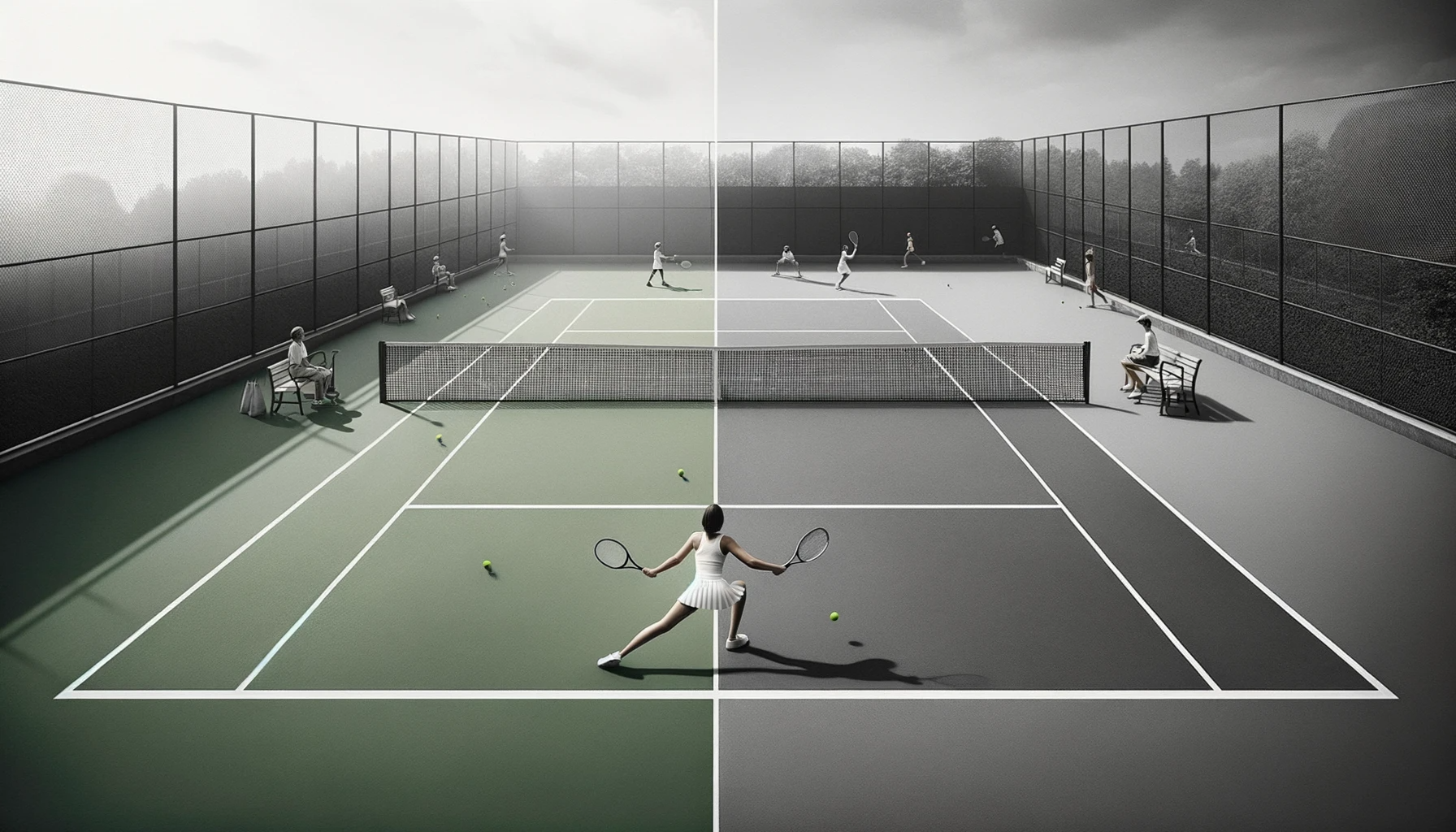In the vast realm of tennis, beginners often find themselves lost amidst a labyrinth of techniques and strategies. Just like a fledgling bird yearns to soar through the skies, novice players yearn to master the basics of the game.
This article aims to guide aspiring tennis enthusiasts through the intricacies of grip and stance, basic shots, court etiquette, and rules. Moreover, it will delve into developing footwork and agility, and offer strategies for effective practice.
Prepare to embark on a transformative journey towards tennis mastery.
Key Takeaways
- Different types of tennis grips: Eastern grip, Western grip, and Continental grip
- Experiment with different grips to maximize performance
- Focus on developing a consistent and accurate serve
- Incorporate ladder drills to improve speed and reaction time
Grip and Stance
The grip and stance in tennis are fundamental elements that contribute to a player’s overall technique and performance. Proper grip allows players to have better control over their shots and generate more power. There are different types of tennis grips, including the Eastern grip, Western grip, and Continental grip. The Eastern grip is commonly used for forehand shots, as it provides stability and control. The Western grip, on the other hand, is suitable for players who want to generate topspin and hit powerful shots. The Continental grip is primarily used for serves and volleys. It is important for players to experiment with different grips to find the one that suits their playing style and maximizes their performance.
In addition to the grip, proper footwork is crucial in tennis. Good footwork allows players to move quickly and efficiently around the court, enabling them to reach the ball in time and maintain balance during shots. It is essential to maintain a wide and stable stance, with the feet shoulder-width apart. This provides a solid base for movement and helps generate power in shots. Players should also focus on footwork patterns, such as the split step, which involves jumping up and splitting the feet apart just before the opponent hits the ball. This enables players to quickly react and move towards the ball.
Basic Tennis Shots
Building on the foundation of grip and stance, mastering basic tennis shots is essential for beginners to develop their skills and understanding of the game. Here are some key shots that every beginner should focus on:
- Forehand: The forehand shot is one of the most fundamental shots in tennis. It involves hitting the ball with the racket’s face parallel to the net, using a swinging motion from the dominant hand side.
- Backhand: The backhand shot is executed by hitting the ball with the non-dominant hand side of the body. It requires a different grip and stroke technique compared to the forehand.
- Serve: Serving techniques are crucial for starting each point. Beginners should focus on developing a consistent and accurate serve. This shot requires a combination of power and accuracy to start the point in a favorable position.
- Volley: Volleying skills are important for playing shots near the net. This involves hitting the ball before it bounces on the player’s side of the court. It requires good hand-eye coordination and precise racket control.
- Overhead: The overhead shot is used when the ball is hit high above the player’s head, often as a response to a lob shot. It requires the player to position themselves correctly and generate power to hit the ball forcefully downwards.
Court Etiquette and Rules
- Beginners must familiarize themselves with the court etiquette and rules of tennis to ensure a respectful and fair playing environment. Understanding the rules and following proper etiquette not only promotes sportsmanship but also contributes to an enjoyable experience for all players involved. Below is a table summarizing some key aspects of tennis etiquette and rules:
| Etiquette | Rules |
|---|---|
| 1. Respect opponents | 1. Scoring system |
| 2. Maintain silence | 2. Equipment regulations |
| 3. Retrieve balls | 3. Court boundaries and lines |
| 4. Follow dress code | 4. Player conduct and penalties |
Regarding scoring, tennis follows a unique system. Players accumulate points in sets, games, and matches. Equipment regulations ensure fairness and player safety. The size, weight, and material of the racket, as well as the type of balls used, are strictly regulated. Court boundaries and lines define the playing area, and players must be aware of them to avoid infractions. Lastly, player conduct is important, and violations may result in penalties or disqualification.
Developing Footwork and Agility
To enhance their performance on the tennis court, novice players should focus on developing precise and agile footwork. Footwork is essential in tennis as it allows players to move quickly and efficiently around the court, enabling them to reach balls and maintain balance during strokes. Here are some key strategies to improve footwork and agility:
- Incorporate ladder drills: Ladder drills are an effective way to improve speed and reaction time. These drills involve moving your feet quickly in various patterns through the rungs of a ladder. This helps to enhance coordination and foot speed.
- Utilize an agility ladder: An agility ladder is another valuable tool for developing footwork and agility. By performing various drills using an agility ladder, players can improve their lateral movement, quickness, and change of direction.
- Practice directional changes: Tennis requires players to change direction frequently. By incorporating drills that involve rapid changes in direction, such as side shuffling or diagonal running, players can enhance their agility and ability to quickly adjust their positioning on the court.
- Focus on quick recovery: After hitting a shot, it is crucial to recover quickly to a balanced and ready position. Incorporate drills that emphasize recovery steps, ensuring that you are prepared for the next shot.
- Incorporate plyometric exercises: Plyometric exercises, such as bounding or box jumps, can enhance explosive power and improve overall athleticism, which are essential for quick movements on the tennis court.
Strategies for Effective Tennis Practice
To optimize their training sessions, novice players should implement effective strategies for practicing tennis. These strategies include mental preparation and equipment selection. Mental preparation is crucial as it helps players focus and stay motivated during practice sessions. It involves setting clear goals, visualizing success, and developing a positive mindset. By mentally preparing themselves, players can enhance their performance and make the most of their practice time.
Equipment selection is another important aspect of effective tennis practice. Players should choose the right equipment that suits their skill level and playing style. This includes selecting the right racket, tennis balls, and court shoes. A well-suited racket can improve a player’s control and power, while appropriate tennis balls can help players develop better strokes and consistency. Additionally, wearing comfortable and supportive court shoes can prevent injuries and provide stability during movements on the court.
In summary, implementing strategies such as mental preparation and equipment selection can greatly enhance the effectiveness of tennis practice sessions for novice players. By focusing on these aspects, players can optimize their training and improve their overall performance on the court.
| Strategies for Effective Tennis Practice |
|———————|———————|———————|
| Mental preparation | Equipment selection | |
| – Set clear goals | – Choose the right | |
| – Visualize success | racket | |
| – Develop a positive| – Select suitable | |
| mindset | tennis balls | |
| | – Wear comfortable | |
| | and supportive | |
| | court shoes | |
Frequently Asked Questions
What Are the Different Types of Tennis Grips and When Should I Use Each One?
Different tennis racket grips serve specific purposes in the game. The Eastern grip offers control, while the Western grip enhances topspin. The Semi-Western grip combines both. Mastering each grip enables players to adapt to various playing styles and court surfaces.
How Do I Properly Position My Feet and Body When Hitting a Forehand or Backhand Shot?
Proper foot and body positioning is crucial for effective forehand and backhand shots in tennis. Maintaining balance and transferring weight correctly enhances shot power and accuracy. Mastering these fundamentals is essential for all tennis players.
Is There a Specific Code of Conduct I Should Follow While Playing Tennis, Especially in Regards to Sportsmanship and Fair Play?
When playing tennis, it is essential to adhere to a specific code of conduct that emphasizes good sportsmanship and fair play. This promotes a positive and respectful environment for all players involved.
How Can I Improve My Speed, Quickness, and Agility on the Tennis Court?
To improve agility, speed, and quickness on the tennis court, one can engage in effective exercises specifically designed for tennis court agility. These exercises focus on enhancing footwork, reaction time, and overall athleticism, resulting in improved performance on the court.
What Are Some Advanced Strategies and Techniques That Can Help Me Enhance My Practice Sessions and Make Them More Effective?
To enhance practice sessions and make them more effective, advanced practice techniques and effective training methods can be employed. These strategies and techniques are designed to optimize skill development and improve overall performance on the tennis court.
Conclusion
In conclusion, mastering the basics of tennis is crucial for novice players to progress to a higher level of skill and expertise. By focusing on grip and stance, basic shots, court etiquette and rules, footwork and agility, as well as effective practice strategies, players can develop a solid foundation in tennis.
Just as a well-tuned instrument produces harmonious melodies, honing these fundamental elements will enable players to orchestrate their game with precision and finesse.








No Comment! Be the first one.